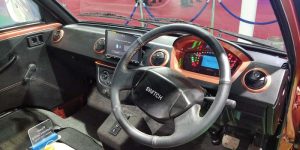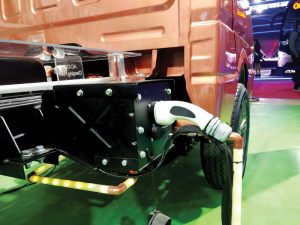Switch Mobility forayed into e-LCVs as hinted at earlier. Ashish Bhatia looks at the tweaks to the modular architecture for the new launch driving the green mobility strategy, afresh.
Switch Mobility was aptly stationed alongside the Ashok Leyland booth at the Auto Expo 2023 – The Motor Show. The company, as hinted earlier during its electric bus launches in 2022, came good on the time line of its intended electric Light Commercial Vehicles (e-LCV) foray. The e-LCV segment is the other priority segment after electric buses for Switch. Having given a sneak peek at the work underway on previous occasions, the power train modularities for e-LCVs fructified. The Switch ion platform also underpins the bus range, from the Switch EiV 9 Standard to the ultra-low floor Switch EiV 12 up to the double-decker Switch EiV 22, most recently in the news for deliveries in India to STUs BEST in Maharashtra and BMTC in Bengaluru besides the G20 run. The products have also entered Chandigarh, Patna and Ahmedabad.
Drawing on its Ashok Leyland and Optare DNA, the LCV foray is a testimony to the flexibility and the go-to-market agility at our disposal, and an outcome of a journey that began a decade ago, averred Dheeraj Hinduja, Executive Chairman at the company. He said, “It is when we positioned an all-electric bus in the UK a decade ago when the industry, globally, was uncertain about the future of electric vehicles.” “We are fortunate to have Optare in the UK with the proven track record in electric vehicles and Ashok Leyland with its rich market presence, brand equity and above all the rich history of product introductions,” he expressed.
With capabilities to tap into both value and premium segments, globally with its presence in India, the UK and Spain, the company is banking on low-cost engineering support from the India base, the added advantage for the company as per Hinduja. He drew attention to the addressable EV market opportunity in buses, estimated at a “conservative” USD 16 bn by 2030 as per McKinsey studies with a volume of over 42,000 units. Here, the company as per Hinduja, expects the LCV business to be USD 55 bn with a volume of over 420,000 units implying a large market potential for the future growth of Switch. The progress is largely dictated by high battery prices and federal ground, and the momentum has picked up. Hinduja drew attention to the high acquisition costs being addressed by Emobility-as-a-Service (EmaaS) through Switch’s subsidiary company, Ohm Mobility, vehicle subscriptions, and Battery as a Service (BaaS) options among Value-Added Services (VAS) for an end-to-end connected EV fleet management system.

to meet the demanding needs of the urban community
While the field may be open for multiple players, the company would like to focus on a profitable and sustainable basis with its innovative products and solutions aimed at offering the lowest Total Cost of Ownership (TCO). The latter is achieved through light-weighting, modularity, best-in-class battery packs and state-of-the-art digital adaptation. In line with a global strategy, the company has expanded to nine sites across three countries. It is looking forward to entering new markets in the near term. Backed by the Sterling Pound 300 mn, a recent investment, a new technical centre in Warwick, in the UK and the new office in Chennai with ~4000 employees. The company is confident of the government’s impetus on infrastructure fuelling the growth of the CV segment where Switch has the right mix of products in both the e-bus and the e-LCV range. The company hopes to launch the showcased e-LCVs soon.
Going deeper, Mahesh Babu, Chief Executive Officer at the company took the press gathering through the new range that marked the e-LCV foray in cargo and people mover categories. The iEV series had the company display the GVW 2.6-tonne (2620 kg) e-LCV truck. The truck offers a volume load of 250 Cu. ft. with a ~150 km range (non-AC) at a 70 kmph speed limit. It draws its power from a motor that has a peak rated power of 40 kW. Babu cited the cornerstone of this development as being the customer needs that have evolved. Today’s fleet operator needs an efficient fleet management system, on a vehicle that’s both modular and intelligent. Like in the case of Switch buses, the platform will be used to shape up multiple cargo models that will be more voluminous over weighing heavier. Through the new range, the company will offer best-in-class payload, range and TAT that is backed by reliability. It will span a spectrum from upwards of 1.2-4.5 tonnes.
Drawing attention to the EV industry in India growing to 10 mn units in 2022, he mentioned, “The e-bus market is going to double this year and is expected to triple in the next fiscal. The e-bus market is expected to grow 10x in the next five years with the Switch and the order book at Switch is a testimony of the company growing over the industry average.” In India, Babu pegged the bus industry at ~85,000 units for five-metre to 12m buses. Here the nine-metre to 10m buses are estimated to be around 40,000 units, he said. The company expects EVs to attain ~50 per cent of that volume in the decade for which the company is gearing up. Laying further context, he added that the company had its first e-bus ready over eight years back with work on EVs underway a decade back. The company today has a global footprint, with 750 employees with a ~300-member strong R&D team and ~300 buses running across the globe having clocked ~50 mn kilometres. Using data, the company has optimised its products. In line with its objective to “democratise carbon mobility”, the company wants to make EVs more accessible.



In a further expansion of its bus portfolio, the Switch EiV 7 bus unveil is aimed at last-mile mobility. Unveiled by Nitin Gadkari, Minister of Road Transport and Highways of India, the latest addition to the EiV series, is claimed to have been uniquely configured to meet the demanding needs of the urban community such as last-mile connectivity through metro feeders and smart commute for staff and school applications besides as campus shuttles. Babu claimed, “In the Indian electric bus market, private operators are showing keen interest, given the lower total cost of operations and sustainability commitments. He explained that the EiV 7 is built on an advanced architecture, contributing to enhanced operational efficiency and superior performance. The 650V architecture for India is at par with its EU solution, he exclaimed.

The bus brings along customer-centric technology and passenger comfort with a low floor, luxurious seating, in-vehicle connectivity and a superior ride quality. Powered by the new generation, modular batteries with advanced NMC chemistry, specially formulated for the Indian market and climatic conditions, the bus is known to be embedded with proprietary technology solutions of Switch iON that enables remote, real-time diagnostics and monitoring. With Switch iON, the company has introduced features like satellite tracking, charging tracker, and OTA updates among uptime solutions including ADAS and Driver Dashboard as a bundled suite offering around 100 plus features for diagnostic and prognostic needs. With an assurance of best-in-class TCO, it can clock 250 kms with a dual charging gun. For the charging ecosystem, the company has partners in Duosida and Seimens for multiple configurations. It is claimed to charge 0-80 per cent in under an hour. In an hour and a half, the architecture facilitates a top-up of 300 kms in intercity applications. Powered by Dana’s globally competent technology of 235 kW and a 3000+ Nm torque, the company can offer nine-and 12m buses too.

The battery pack is claimed to be 30 per cent lighter than the competition and offers high energy density. With a claimed ~4000 cycles plus life, the company is offering eight years warranty to back the claim. These packs are configurable upwards of 110 kW to 460 kW with a two-speed thermal management system. Safety is enhanced with a three-layer (module, battery and string level including vehicle level components with a (-) five degrees to 55 degrees. Using data analytic and mining, with the capability of collecting close to two terabytes of data. The company has attained ~18 per cent energy efficiency as a tangible outcome as per Babu.
The company also showcased an open-top, hop-on hop-off tourist application for the intra-city segment on the Switch EiV 22. Carrying forward the wide front and rear doors, two staircases, and an emergency door complying with the latest safety standards, the bus optimised to seat 65 passengers is powered by a 231 kWh capacity, two-string, liquid-cooled, higher density NMC chemistry battery pack also with a dual gun charging system. It boasts a 250 km range for intra-city applications. The next-generation, modular architecture with superior technology has enabled Switch to attain both scale and customer-centricity.
Also read, Switch Mobility launches SWITCH e1




















